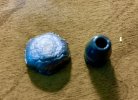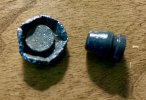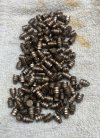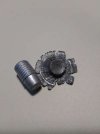...His methodology was to drop the charge bit by bit until he stuck a bullet, then back to the lowest charge that didn't stick a bullet....
Not to discredit, but to reinforce - this method is not "new" or unique. Maybe not widely known, let alone accepted, but I've studied this for some time and have experimented with it a great deal. There were at least three site I had bookmarked on the topic which have since disappeared.
Using the same logic and method, I've developed loads shooting 158 grain 357 bullets from 357 Mag carbines and one thing which I will suggest one pays close attention to is that each barrel will be a different story. I started this experiment with a 357 Mag Rossi 92, which had a .355" groove and an amazingly pretty, shiny bore. I could push the 158s at about 450 fps out the muzzle with utter reliability - 100%. These loads were incredibly effective on 'coons destroying property. Body shots at a couple to fifteen yards or so and the 'coon would stiffen momentarily and then slump - no exit wound. Head shots were always dramatic - a 'coon with half (or less) a head left, thrashing about for almost a minute, making a terrible mess.
Two different H&R Handi-Rifles worked almost as well, but required slightly more powder, which rendered slightly more noise, larger groove diameters, not AS smooth bores, but still very quiet and very effective, just not AS quiet as the Rossi with the really right bore.
I got this notion to "upgrade" and bought a Ruger 77/357. The bore looked terrible in comparison to the cheaper guns as did the whole gun. I could not get this gun to perform anywhere near the level of the other guns, requiring almost twice the powder (still a low-level target load at that point) and a lot of extra noise. I stick quite a few in that Ruger barrel trying to find its "sweet spot" and once I did - it was too loud and too fast. I amn trying really hard to be objective and not disparage that rifle, as it's not the point, but it DID indicate to me that you must THOROUGHLY test each and every barrel and never assume such a load will work in another gun.
Assuring that the bullet cleared the muzzle EVERY SINGLE TIME is (EMPHATICALLY) IMPERATIVE! And,... it's a pain in the neck with a repeater. Secondary lesson was that the break-opens were SO much easier to check for a clear bore each time you extracted a spent case.
NOW, I am using a Contender Carbine, with a 18" MGM barrel, which is pretty nice inside, and can get pretty much the same from it as the Rossi I started with. It is very convenient to deliver quiet, DECISIVE and undramatic dispatching shots on tough vermin. Not too long ago, I had to dispatch a wary and sizable woodchuck who'd taken up residence very near my back porch. Had it attracted a mate, my back porch would have been a haven to a batch of borers, except that, from about 30', I put a quiet and non-dramatic end to his ambitions. Again, at about 450 fps, a 158 grain(ish) HP SWC, cast very soft and no exit wound.
Bottom line, you really can't be an idiot about this, but it is a legitimate, viable and useful means if you are diligent in your research and experimentation and don't just take some Internet commando's word for it - MYSELF INCLUDED. It's all on you to go about this in a safe manner. It's tedious and requires patience and DILIGENCE.
EDIT: Though I did live in the "low country of SC" for a while, I was not "the guy on the other forum."




